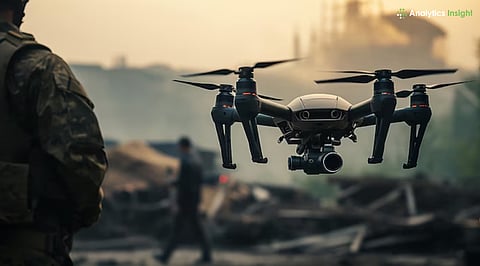

In the 2025 Pakistan conflict, India's Harop and Heron drones played a pivotal role, delivering precision strikes and advanced surveillance capabilities that provided a crucial strategic advantage. These cutting-edge drones showcased India's technological prowess, enabling precise targeting and real-time intelligence gathering.
The 2025 India-Pakistan conflict, initiated by a terrorist attack in Kashmir, witnessed the advent of a new era in modern warfare as drones took the center stage. Nicknamed Operation Sindoor, India's action included cutting-edge unmanned aerial vehicles (UAVs) for reconnaissance and targeted attacks.
This article recounts the most notable drones employed by India, their functionality, and their role in the brief but intense conflict, highlighting the growing significance of drone technology in war.
Tensions escalated on April 22, 2025, when 26 civilians, who were primarily tourists, were murdered by a militant attack in Pahalgam, Kashmir. India blamed Pakistan for assisting terrorism, leading to Operation Sindoor on May 7. The operation struck militant camps but Pakistan said it struck civilian neighborhoods, resulting in retaliatory missile and drone strikes.
Each country used drones heavily, the first drone-focused battle between the nuclear neighbors. A ceasefire was reached on May 10, but there were reports of violations.
The Harop, which Israel Aerospace Industries (IAI) developed, was India's top loitering munition. Nicknamed a "kamikaze drone," the Harop integrates reconnaissance and explosive capability in one platform with a 23 kg warhead. With six hours of loiter time and the ability to attack targets at 200 km, the Harop detects enemy radar emissions independently, making it perfect for counter-air defense.
In Operation Sindoor, India had deployed dozens of Harops and struck Pakistani military bases in the cities of Lahore and Karachi. Reports indicate a few penetrated defenses and inflicted a lot of damage, even though Pakistan had claimed it shot down 25.
An older IAI model, Harpy, assisted Harop in Indian stockpiles. For Suppression of Enemy Air Defenses, it targets and kills radar waves by crashing against the source. Although less sophisticated than the Harop, the Harpy was efficient in the conflict of 2025.
Ironically, it even knocked out one Chinese-supplied HQ-9 air defense battery in Lahore, demonstrating its contemporaneity. The Harpy's capability of jamming the radar systems in Pakistan enabled India to enjoy superiority in the skies in crucial situations.
The IAI Heron was a medium-altitude, long-endurance (MALE) UAV that used to be the main reconnaissance vessel of India. With a capability to remain airborne for 52 hours, it collected real-time intelligence, surveillance, and reconnaissance (ISR). While the Harop and Harpy were expendable, the Heron is reusable and features state-of-the-art sensors for tracking large tracts of territory.
During the war, Herons were deployed along the border, picking up Pakistani military movements and directing artillery fire. Their altitude advantage placed them beyond the capability of most anti-aircraft defenses, providing unceasing battlefield awareness.
The IAI Searcher Mk II, another Israeli drone, assisted India's tactical operations. With an 18-hour endurance and payload of 300 km, it was top-notch for frontline reconnaissance. Searchers monitored Pakistani swarms of drones and border incursions, enabled gun-laying and target location. In significant numbers along the Line of Control (LoC), they increased India's situational awareness, especially in combat areas that were rapidly shifting.
The SkyStriker, a Bengaluru-made drone from Alpha Design and Israel's Elbit Systems, proved to be a game changer. Acquired post-2019 Balakot strikes, it has a 5-10 kg warhead and hammers with millimeter precision.
SkyStrikers hit terrorist camps during Operation Sindoor, firing live video reports of attacks without being detected by Pakistan's defences. Having silent flight mode and two-way communication, India was able to strike nine terror targets with no collateral damage while demonstrating cutting-edge indigenous technology.
Pakistan's counterattacks by drones, with Turkish Bayraktar TB2 and Chinese Wing Loong II, tried to probe India's defenses. India's Drone-Detect, Deter, and Destroy (D4) system, which DRDO created, stood up well.
This multi-sensor system jammed more than 50 Pakistani drones on May 8-9 through radar, lasers, and electronic jamming. Interoperated with Akash and S-400 systems, the D4 ensured that no hostile UAV entered Indian airspace, guarding Jammu, Srinagar, and Bhuj bases.
Drones provided India with a strategic advantage in the 2025 war, allowing for pinpoint attacks and instant intelligence without putting pilots at risk. Harop, Harpy, Heron, Searcher, and SkyStriker showed a combination of foreign and local technology, reducing reliance on manned platforms.
Pakistan's drone strength, supported by Turkey and China, however, indicates an emerging arms race. More autonomous and swarms of drones can be expected in future conflicts, increasing escalation risks in South Asia. India's investment in anti-drone systems such as D4 shows it to be ready for this new battlefield.
